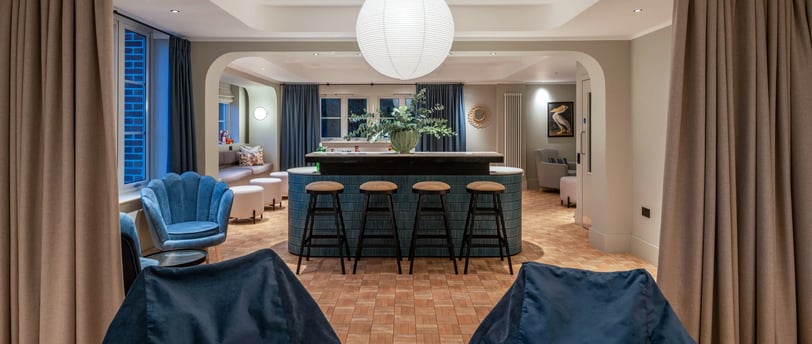Creating Workspaces That Inspire: Office Interior Design Tips


The Importance of Office Design
Office design plays a vital role in shaping the overall workplace environment, ultimately influencing both productivity and employee morale. A well-thought-out workspace can significantly enhance motivation and creativity among employees, fostering a sense of belonging and satisfaction. When individuals are placed in an environment that is visually appealing and functionally efficient, they are more likely to engage actively in their work and contribute to the overall success of the organization.
Research has shown that the physical surroundings of a workspace can have a profound effect on employee health and well-being. Elements such as natural light, ergonomic furniture, and open spaces can help reduce stress levels and promote a more positive atmosphere. Consequently, a thoughtfully designed office can facilitate collaboration and communication among team members, leading to innovative ideas and solutions. Enhanced interaction is essential in modern workplaces, where creativity often thrives within diverse groups.
Furthermore, office design directly impacts employee satisfaction, which is a crucial factor in talent retention. Organizations that invest in creating comfortable and inspiring workspaces are likely to see a decrease in turnover rates, saving them substantial costs associated with hiring and training new staff. Employees who feel valued and comfortable in their surroundings are generally more committed to their roles, resulting in long-term benefits for the organization as a whole.
To summarize, the significance of thoughtful office design cannot be overstated. By prioritizing the aesthetic and functional aspects of workspace design, organizations can cultivate an environment that not only inspires creativity and productivity but also nurtures the well-being of its employees. Investing in a well-designed office is ultimately an investment in the organization's future success.
Key Elements of Modern Office Design
Modern office design is an intricate blend of functionality and aesthetics, with several key elements that contribute to an inspiring workplace. One of the most fundamental aspects is the layout of the office space. Effective layouts prioritize collaboration and communication while also allowing for privacy when needed. An open-plan environment can encourage teamwork, but incorporating designated quiet areas is essential for tasks requiring concentration. Such a thoughtful arrangement can cater to the diverse needs of employees, fostering both creativity and productivity.
Color schemes play a pivotal role in modern office design, influencing mood and motivation. Soft, neutral tones may cultivate a sense of calm, while vibrant colors can stimulate energy and creativity. The selection of colors should not be arbitrary; instead, it should align with the company’s branding and the desired atmosphere of the workspace. Essential to this palette are accents and decorative elements that provide visual interest without overwhelming the senses.
Furniture is another crucial element in the contemporary office aesthetic. Ergonomically designed desks and chairs promote employee well-being and productivity, showing a commitment to health. Additionally, modular furniture can enhance flexibility, allowing teams to adapt their spaces as needed. Furniture not only serves functional purposes but also contributes to the overall design narrative of the office.
Lastly, lighting is vital in creating an inspiring environment. A well-designed office provides a balanced mix of natural and artificial light, enhancing focus and reducing eye strain. Incorporating large windows or skylights can invite natural light, making the workspace feel more open and connected to the outdoors. Task lighting, on the other hand, can be strategically used to illuminate work areas efficiently.
Collectively, these elements form the foundation of modern office design, creating a workspace that supports the operational needs of a diverse workforce while enhancing the overall employee experience.
Creating Collaborative Spaces
In contemporary office design, the significance of collaborative spaces cannot be overstated. Collaborative workspaces foster teamwork and enhance communication among staff members, thereby increasing overall productivity and morale. To achieve this, it is essential to consider various design elements that promote interaction and collaboration.
One of the most effective strategies in creating such spaces is the implementation of open layouts. Unlike traditional cubicles that can create barriers between employees, open layouts encourage movement and communication, allowing team members to engage more freely. By reducing physical obstructions, employees feel more connected and are more likely to exchange ideas spontaneously. Moreover, incorporating designated areas within open layouts, such as breakout zones or huddle spots, can provide teams with the flexibility to gather informally and brainstorm effectively.
Comfortable seating arrangements play a crucial role in the design of collaborative spaces. Opting for adaptable furniture allows employees to create their own seating configurations based on their working styles and needs. Soft seating, such as bean bags or lounge chairs, can complement more traditional desks, inviting employees to choose where and how they wish to work. Additionally, having various seating options encourages employees to engage with colleagues in a more relaxed and innovative environment.
Communal workstations are another valuable addition when designing collaborative spaces. These stations facilitate teamwork by allowing multiple staff members to work together actively. Designating areas with shared resources such as whiteboards, technology hubs, and power outlets encourages groups to engage in real-time collaboration, allowing ideas to flow more naturally. Furthermore, integrating plants and natural lighting into these spaces can enhance creativity and create a more inviting atmosphere.
Ultimately, designing collaborative spaces that reflect these principles will cultivate a work culture that values teamwork and open communication, leading to a more engaged and dynamic workforce.
Incorporating Biophilic Design
Biophilic design is an innovative approach in office interior design that seeks to establish a profound connection between individuals and nature. This concept recognizes that nature has a vital role in enhancing the well-being, productivity, and overall satisfaction of employees. By integrating elements of nature into the workspace, organizations can create environments that not only inspire creativity but also foster a sense of calm and alertness. There are several ways to integrate biophilic principles into office design effectively.
One of the primary methods to achieve this is through the incorporation of plants. The presence of greenery in the workspace has been shown to reduce stress, purify the air, and improve overall mood. Office interiors can benefit from a variety of plants, ranging from low-maintenance options like succulents to larger species such as fiddle leaf figs. Strategic placement of these elements throughout the space ensures that they are visible and accessible, enhancing the connection between the employees and the natural environment.
Another crucial aspect of biophilic design is maximizing natural light. Studies indicate that exposure to natural light significantly boosts employee morale and productivity. When designing office spaces, large windows, skylights, and open layouts should be prioritized to allow as much daylight as possible. Additionally, using light-colored materials and surfaces can help reflect natural light throughout the space, creating a more inviting atmosphere.
Lastly, integrating organic materials into office design is essential. Natural materials such as wood, stone, and textiles mimic the qualities of the natural world, evoking a sense of familiarity and comfort. By incorporating these elements into furniture and decor, workplaces can enhance their aesthetic appeal while promoting employee well-being.
Flexible Workspaces for Diverse Needs
In recent years, the concept of flexible workspaces has gained significant traction, transforming the traditional office environment into a dynamic setting that caters to a variety of working styles. These innovative workspaces prioritize adaptability, recognizing that employees have different preferences and requirements when it comes to their work environment. To effectively support diverse needs, organizations are increasingly designing spaces that include quiet zones, collaborative hubs, and lounge areas, each serving distinct purposes.
Quiet zones are essential in any modern office, as they provide serene environments where employees can focus without distractions. These areas are equipped with soundproofing features and minimalistic decor to foster concentration. By offering a dedicated space for deep work, organizations empower employees to be more productive and efficient, addressing the varying demands of their tasks.
On the other hand, collaborative hubs are designed to encourage teamwork and communication. These spaces typically feature open layouts, comfortable seating arrangements, and whiteboards or technology to facilitate brainstorming sessions. By fostering an environment that promotes collaboration, companies can enhance creativity and innovation among their teams, recognizing that teamwork is often a key component of successful project outcomes.
Lounge spaces play a crucial role in employee well-being, offering areas for relaxation, informal discussions, and social interactions. These comfortable zones often include amenities like sofas, coffee stations, and games, allowing employees to recharge both mentally and physically. By incorporating lounge spaces, organizations acknowledge the importance of work-life balance, which is vital for maintaining employee satisfaction and retention.
Ultimately, the trend of flexible workspaces signifies a shift towards a more inclusive approach to office design, where the needs and preferences of all employees are acknowledged. By thoughtfully integrating various types of areas within an office, companies can create an inspiring and productive environment that caters to the diverse working styles of their workforce.
Color Psychology in Office Design
Color psychology plays a significant role in workplace design, as the colors chosen for an office environment can greatly influence employee mood and productivity. Research indicates that different colors evoke various emotional responses, which can either enhance or hinder concentration and creativity. An understanding of these psychological effects is crucial for designing an office space that fosters an inspiring and motivating atmosphere.
For instance, blue is often associated with calmness and stability. Incorporating blue tones into office design can promote a sense of tranquility and focus among employees, making it an ideal choice for spaces where concentration is paramount. Conversely, yellow, symbolizing optimism and energy, can stimulate creativity and inspire innovative thinking. Thus, using yellow accents or furniture in collaborative areas may encourage teamwork and idea generation.
Green, representing nature and growth, can also be an excellent addition to office spaces. It is linked to increased feelings of relaxation and balance, making it a positive choice for reducing stress during intense work periods. By integrating plants or green color schemes, companies can create a harmonious environment conducive to employee well-being and productivity.
On the other hand, red is a color that can evoke strong emotions, such as excitement and passion, but it can also lead to stress and aggression if overused. Therefore, while red can be beneficial in areas designed for high-energy discussions or brainstorming sessions, it should be applied thoughtfully and sparingly to avoid overwhelming employees.
In conclusion, when designing an office space, careful consideration of color psychology can lead to a more productive and inspiring environment. By selecting colors that align with the desired emotional and functional outcomes, organizations can create workspaces that enhance employee engagement and overall performance.
Personalizing Your Workspace
Personalization of workspace settings is not merely an aesthetic endeavor; it plays a critical role in fostering employee comfort and satisfaction. Both employers and employees should consider integrating elements that allow individuals to express their personalities within their work environments. One effective way to achieve this is by encouraging the display of personal artwork or décor items that resonate with the employee's tastes and interests.
Incorporating elements such as photographs, inspirational quotes, or even small plants can significantly enhance the ambiance of a workspace. These personal touches can serve as conversation starters and contribute to a collaborative atmosphere, thus improving workplace relationships. Employers should create guidelines that safely allow employees to personalize their areas while maintaining a degree of corporate identity.
Furthermore, customized workspace layouts can promote a sense of ownership among employees. For instance, providing adjustable desks or private nooks can empower individuals to create an environment that suits their work habits and preferences. Encouraging employees to rearrange their desks or select their office chairs can contribute to their sense of control, which is vital in cultivating a productive workplace.
Moreover, integrating technology can enhance the personal workspace experience. Allowing employees to use personal devices or providing software that tailors to their work style can improve their efficiency and comfort. Flexible technologies that adapt to individual preferences can lead to a better overall job performance.
In conclusion, permitting personalization within office environments breeds a more engaged workforce. By allowing employees to infuse their personal style into their workspace, companies foster a culture of belonging and satisfaction, which can ultimately lead to increased productivity and morale in the workplace.


